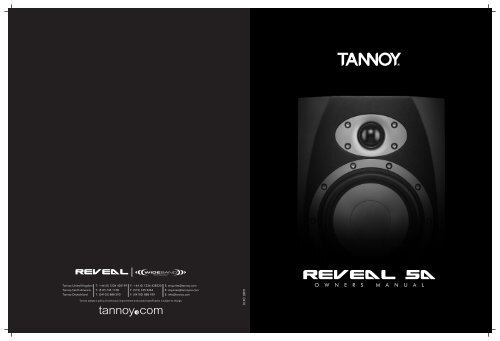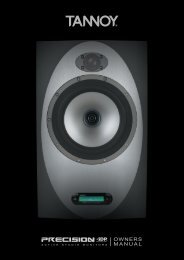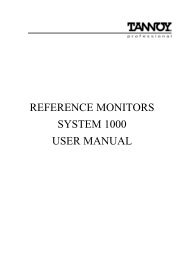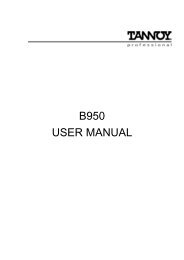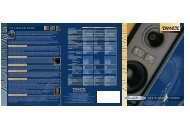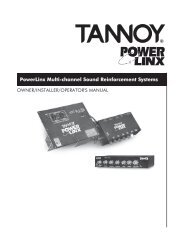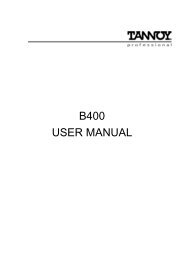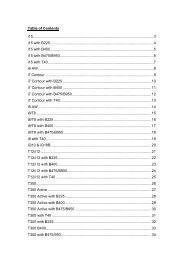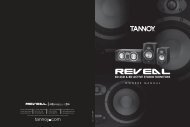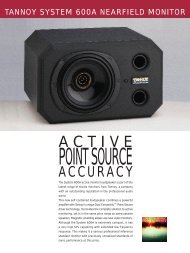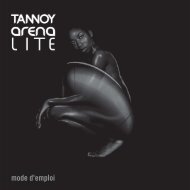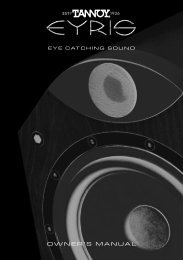490.68 KB.pdf - Tannoy
490.68 KB.pdf - Tannoy
490.68 KB.pdf - Tannoy
You also want an ePaper? Increase the reach of your titles
YUMPU automatically turns print PDFs into web optimized ePapers that Google loves.
<strong>Tannoy</strong> United Kingdom T: +44 (0) 1236 420199 F: +44 (0) 1236 428230 E: enquiries@tannoy.com<br />
<strong>Tannoy</strong> North America T: (519) 745 1158 F: (519) 745 2364 E: inquiries@tannoyna.com<br />
<strong>Tannoy</strong> Deutschland T: (04102) 888 393 F: (04102) 888 959 E: info@tannoy.com<br />
<strong>Tannoy</strong> adopts a policy of continuous improvement and product specification is subject to change.<br />
6481 0410<br />
O W N E R S M A N U A L
CONTENTS<br />
1.0: IMPORTANT SAFETY INSTRUCTIONS<br />
2.0: INTRODUCTION<br />
3.0: THE BASICS 3.1 Unpacking and visual checks<br />
3.2 Preliminary recommendation<br />
3.3 Connecting your speakers<br />
4.0: PLACEMENT OF THE SPEAKERS 4.1 Orientation<br />
4.2 Positioning<br />
4.3 Console Reflections<br />
4.4 Speaker Mounting<br />
4.5 Bass Ports<br />
4.6 Equalisation<br />
5.0: REVEAL 5A DIMENSIONS<br />
6.0: PERFORMANCE DATA<br />
7.0: TECHNICAL SPECIFICATIONS<br />
8.0: SERVICING 8.1 Cabinet finish<br />
8.2 Driver removal<br />
8.3 Crossover<br />
8.4 List of spare parts<br />
9.0: WARRANTY<br />
10.0: DECLARATION OF CONFORMITY<br />
ELECTRICAL REQUIREMENTS<br />
Check that the voltage rating displayed on the rear panel is correct for your area before connecting. If it is incorrect, please refer to your local dealer or authorised<br />
service agent, as no user adjustment is provided.<br />
WARNING!<br />
• To reduce the risk of fire or electric shock, do not expose this apparatus to rain or moisture.<br />
• Be advised that different operating voltages require the use of different types of line cord and attachment plugs.<br />
• Check the voltage in your area and use the correct type. See table below:<br />
VOLTAGE LINE PLUG ACCORDING TO STANDARD<br />
110-125V UL817 and CSA C22.2 no 42.<br />
220-230V CEE 7 page VII, SR section 107-2-D1/IEC 83 page C4.<br />
240V BS 1363 of 1984. Specification for 13A fused plugs and switched and un-switched socket outlets.<br />
SERVICE<br />
There are no user-serviceable parts inside. Qualified personnel must perform all service. Servicing is required when: -<br />
• The unit has been damaged in any way, such as when the power-supply cord or plug is damaged.<br />
• The unit has been exposed to rain or moisture, or liquid has been spilled into the unit.<br />
• Objects have fallen into the unit.<br />
• The unit does not work properly.<br />
• The unit has been dropped.<br />
EUROPEAN MODELS<br />
A mains cable is supplied with an IEC moulded socket at one end and a moulded mains plug at the other end. Where the moulded plug is fitted with a mains fuse,<br />
always replace with the same 5A rated fuse. If the fitted plug is unsuitable for your type of outlet sockets, it should be cut off and disposed of safely, in case it is<br />
inserted into a live socket elsewhere. The wires in the mains cable are coloured in accordance with the following code:<br />
GREEN AND YELLOW EARTH<br />
BLUE NEUTRAL<br />
BROWN LIVE<br />
AS THE COLOURS OF THE WIRES IN THE MAINS CABLE MAY NOT CORRESPOND WITH THE COLOURED MARKINGS IDENTIFYING THE TERMINALS IN YOUR<br />
PLUG, PROCEED AS FOLLOWS:<br />
The wire which is coloured GREEN AND YELLOW must be connected to the terminal in the plug which is marked either by the letter E, the earth safety symbol, or<br />
coloured GREEN or GREEN and YELLOW.<br />
The wire which is coloured BLUE must be connected to the terminal in the plug which is marked by the letter N or coloured BLACK.<br />
The wire which is coloured BROWN must be connected to the terminal in the plug which is marked by the letter L or coloured RED.<br />
Ensure that the terminals are tightened securely, and no loose strands of wire are present. Ensure cord grip is clamped over outer sheath of cable, rather than over<br />
the wires.<br />
1.0: IMPORTANT SAFETY INSTRUCTIONS<br />
1. Read these instructions.<br />
The lightning flash with an arrowhead symbol within an<br />
2. Keep these instructions.<br />
equilateral triangle, is intended to alert the user to the<br />
presence of uninsulated “dangerous voltage” within the<br />
3. Heed all warnings.<br />
product’s enclosure that may be of sufficient magnitude<br />
to constitute a risk of electric shock to persons.<br />
4. Follow all instructions.<br />
5. Do not use this apparatus near water.<br />
6. Clean only with dry cloth.<br />
7. Do not block any ventilation openings. Install in accordance with manufacturer’s instructions.<br />
The exclamation point within an equilateral triangle is<br />
intended to alert the user to the presence of important<br />
operating and maintenance (servicing) instructions in the<br />
literature accompanying the product.<br />
8. Do not install near any heat sources such as radiators, heat registers, stoves, or other apparatus (including amplifiers) that produce<br />
heat and ensure adequate air circulation around the rear of the product.<br />
9. Do not defeat the safety purpose of the polarised or grounding-type plug. A polarised plug has two blades with one wider than the other.<br />
A grounding type plug has two blades and a third grounding prong. The wide blade or the third prong are provided for your safety. If the<br />
provided plug does not fit into your outlet, consult an electrician for replacement of the obsolete outlet.<br />
10. Protect the power cord from being walked on or pinched particularly at plugs, wall sockets, and the point where they exit from the apparatus.<br />
11. Only use attachments/accessories specified by the manufacturer.<br />
12. Unplug this apparatus during lightning storms or when unused for long periods of time.<br />
13. Refer all servicing to qualified service personnel. Servicing is required when the apparatus has been damaged in any way, such as powersupply<br />
cord or plug is damaged, liquid has been spilled or objects have fallen into the apparatus, the apparatus has been exposed to rain<br />
or moisture, does not operate normally, or has been dropped.<br />
14. WARNING: To reduce the risk of fire or electrical shock, this apparatus should not be exposed to rain or moisture and objects filled with<br />
liquids, such as vases, should not be placed on this apparatus.<br />
15. To completely disconnect this equipment from the mains, disconnect the power supply cord plug from the wall socket.<br />
16. The mains plug on the power supply cord shall remain readily accessible.<br />
FUSE PROTECTION<br />
An additional mains fuse is provided in the IEC power inlet on the back of the loudspeaker, which can only be removed with the power cord unplugged. This must be<br />
replaced by a fuse of the same type and ratings (see Specifications or refer to rear panel).<br />
INSTALLATION<br />
Do not install this equipment in an enclosed space. Do not limit free ventilation and movement of air around the back panel. Do not install this equipment in a<br />
cupboard with a closed door. Allow for a distance of 150mm (6 inches) of free air space around all sides, top, bottom and the back panel of this product. The<br />
user must be able to see the blue coloured front panel of this product when in use.<br />
EMC<br />
This equipment has been tested and found to comply with the limits for a Class B digital device, pursuant to part 15 of the FCC Rules. These limits are designed to<br />
provide reasonable protection against harmful interference in a residential installation. This equipment generates uses and can radiate radio frequency energy and,<br />
if not installed and used in accordance with the instructions, may cause harmful interference to radio communications. However, there is no guarantee that interference<br />
will not occur in a particular installation. If this equipment does cause harmful interference to radio or television reception, which can be determined by turning the<br />
equipment off and on, the user is encouraged to try to correct the interference by one or more of the following measures:<br />
• Re-orient or relocate the receiving antenna.<br />
• Increase the separation between the equipment and receiver.<br />
• Connect the equipment into an outlet on a circuit different from that to which the receiver is connected.<br />
• Re-orient or coil cables.<br />
• If necessary, consult the dealer or an experienced radio/television technician for additional suggestions.<br />
Any cables the user adds to the device must be shielded to be in compliance with the FCC standards. Any unauthorised modification to this device could result in<br />
the revocation of the end user’s authority to operate this device.<br />
This device complies with Part 15 of FCC rules. Operation is subject to the following two conditions: (1) This device may not cause harmful interference, and (2)<br />
This device must accept any interference received, including interference that may cause undesired operation.<br />
Canada<br />
Industry Canada Class B emission compliance statement. This Class B digital apparatus complies with Canadian ICES-003.<br />
Avis de conformite a la reglementation d'Industrie Canada. Cet appareil numerique de classe B est conforme a la norme NMB-<br />
003 du Canada.<br />
2 3
2.0: INTRODUCTION<br />
You’re thinking, "Come on, a user’s manual for speakers? That’s like a user’s manual for a toothbrush." You know you should hook them up in phase and then<br />
you listen to them. How much more do you need to know? We know these speakers are headed for the professional or semi-professional studio market, so we<br />
know we don’t need to tell you about putting your potted plants on top of the speakers, or to avoid putting the right one on the bookshelf, and the left one on the<br />
floor behind the sofa. We know you are serious listeners or you wouldn’t have bought <strong>Tannoy</strong> monitors. We decided that someone needed to produce this type of<br />
manual, and because we’re actually interested in monitoring, not just speaker sales, we figured it would have to be us. This user’s manual will tell you how to get<br />
the absolute best performance out of your new monitors.<br />
3.0: THE BASICS<br />
The Reveal 5A is the smallest active playback monitor from <strong>Tannoy</strong>, a company with unrivalled experience in studio monitoring. It has an extremely detailed, dynamic<br />
sound with a wide, flat frequency response – all of which are essential for monitoring with reliable accuracy.<br />
The 25mm (1") soft dome HF unit is seamlessly matched to a 130mm (5") long throw bass unit. The drive units are mounted on a massive 40mm thick baffle, curved<br />
to minimise diffraction and creating the loudspeakers distinctive styling. Both drive units are magnetically shielded to allow the system to be used close to video monitors.<br />
4.0: PLACEMENT OF THE SPEAKERS<br />
Now here’s the truly critical stuff. Speaker placement and the listening environment can completely compromise the performance of any loudspeaker, no matter<br />
how much it costs. It is important to understand some limitations of near-field speakers, and the operating environment, in order for you to gain the maximum<br />
performance from the pair sitting in front of you.<br />
4.1: ORIENTATION<br />
Two-way speakers have a correct orientation for the serious listener. Two way systems use a separate woofer and tweeter mounted in a vertical line on the baffle.<br />
There is a fixed vertical distance between the centre of the two devices on the baffle, and there is fixed distance between the apparent acoustic center of each device<br />
and the plane of the baffle at the crossover point. By stacking the woofer and tweeter vertically, we minimise the problems caused by these physical offsets. The<br />
near-field listening conditions magnify the effects of the driver offsets, so we really need to optimise the speaker orientation. When you are very close to a speaker<br />
system, vertical head movements are significant because your movement represents a large change in angle of arc, and therefore the number of degrees above<br />
and below the axis (that’s the line between the woofer and tweeter). In other words, bob your head up and down a few centimeters within a metre of the cabinet,<br />
and your ear moves through a larger angle relative to the speaker axis than it does with the same vertical motion 4 or 5 metres away. Need proof? Put on some<br />
music, not loud, and get really close, about 500mm (20") away. Move your head up and down now, and you can actually get the musical image to break into a<br />
separate high frequency and low frequency source. This is a wildly exaggerated example of what we’re talking about. It isn’t that bad out here in the normal listening<br />
position, but the variations are still there.<br />
Don’t put potted plants on top of your speakers, or solder your signal leads out of phase. Now that we’ve got that out of the way, let’s talk about some of the technical<br />
things to keep in mind.<br />
3.1: UNPACKING AND VISUAL CHECKS<br />
To remove the speakers from the carton without damage open the end flaps fully and bend them right back (remember they are packed in pairs). Turn the package<br />
upside-down on the floor and lift the carton vertically up to leave the speakers resting on their packing tray. Nothing on or in your speakers should rattle about.<br />
Inspect each speaker for signs of transit damage. In the unlikely event of this having occurred inform the carrier and the supplier. Keep all the packaging if damage<br />
has occurred, as this will show evidence of excessive handling forces. It is also a good idea to keep the packaging if possible for future transportation.<br />
3.2: PRELIMINARY RECOMMENDATION<br />
Initially we would like to give a word of warning on high sound levels, which these speakers are capable of generating over sustained periods of time. Levels over<br />
95 dB for 8 hours per day can eventually cause permanent hearing loss. Because <strong>Tannoy</strong> monitors have very low levels of time, amplitude and frequency distortion<br />
it is not always obvious that the sound level is high while working with them.<br />
For continuous exposure we recommend the occasional use of a sound level meter capable of integrating the sound level over a period of exposure according to<br />
noise control standards. This should be used just to check that noise levels are always within safety limits.<br />
3.3: CONNECTING YOUR SPEAKER<br />
The compact, integrated design of a self powered unit like the Reveal 5A makes it particularly easy to install.<br />
Having chosen an appropriate location for your monitors and arranged them accordingly, connect the power<br />
cord to the mains socket (location 2) and turn the power on (mains switch, location 1). The LED on the front<br />
panel will now glow red. Push the <strong>Tannoy</strong> logo on the front panel to operate the switch to bring the amplifier<br />
out of standby mode and into operational mode. Set the volume control on the front panel to zero (fully<br />
anticlockwise). Connect the audio signal source (console output) to the input connector (combined XLR/jack<br />
socket) at the back of the monitor (location 3).<br />
All two way component systems have to live with some listening position dependent compromises at the crossover point. The crossover frequency of all of these<br />
small systems falls into the center of the midband (2.0kHz to 3.0kHz), where we are most capable of recognising frequency/phase response deviations.<br />
In the diagrams below we have a graphical representation of the speaker systems operating at the crossover point where both high and low frequency drivers produce<br />
the same output level. The first one shows a pair of two-way loudspeakers lying on their side. Note that each driver is producing sound, and because there is a<br />
physical distance separating them on the baffle, there is also a time difference separating the drivers, and the result is what you see here. Around the crossover<br />
point, the speaker will produce numerous lobes, producing changes in midrange sound character as you move across the horizontal listening plane.<br />
HORIZONTAL<br />
As indicated on the silk screen printing, the input connector is wired to the balanced input as indicated below:<br />
SIGNAL (+)<br />
SIGNAL (-)<br />
GROUND<br />
XLR INPUT<br />
pin 2<br />
pin 3<br />
pin 1<br />
JACK INPUT<br />
Tip (T)<br />
Ring (R)<br />
Screen (S)<br />
If the source has a balanced output, use shielded twin conductor cable (microphone cable) connecting pin<br />
2/T to pin 2/T (first inner conductor), pin 3/R to pin 3/R (second inner conductor), and pin 1/S to pin 1/S<br />
(using the shield or drain conductor).<br />
If the source has an unbalanced output, a single conductor shielded cable can be used, connecting pin 2/T<br />
of the input to the "hot" signal pin of the source, while pin 3/R and pin 1/S should be linked together and<br />
connected to the source signal ground.<br />
Fig. 1.<br />
Stereo occurs from left to right, so that is the listening plane in which we try to minimise the changes in physical/time offset between the woofers and tweeters.<br />
By stacking the woofer and tweeter vertically on the baffle we can give the mix engineer the widest range of movement in the horizontal plane. You can roll your<br />
chair across the length of your mixing console and not change the relationship between the woofer and tweeter (just don’t bob your head up and down while you<br />
do it).<br />
4 5
VERTICAL<br />
4.2: POSITIONING<br />
This is the monitor equivalent of a wheel alignment. Where do you aim the speakers to give you the smoothest and most consistent sound, and how far<br />
apart do you place them to give you a good stereo image? The basic rule is to follow the layout of an equilateral triangle. The distance between the two<br />
monitors should be roughly the same as the distance between one monitor and your nose in the listening position where you are leaning forward on the<br />
console armrest. See the following diagram.<br />
Now, if you were to follow the all too common practice of lying your two way monitors on their side to give you better sight lines over your meter bridge,<br />
you can see (and hear) what will happen. With the monitor on its side, moving your head horizontally means you are now moving through all those rays,<br />
or lobes, where the wavefronts from the woofers and tweeters interfere with each other. The midrange frequency response will be different for each head<br />
position. All two way component monitors, no matter who manufactures them, need to be used with the multi-driver axis vertical (that’s just the way it<br />
has to be when you’re in the near-field). And if you’re wondering how three-way near-fields work with a whole bunch of speakers stuck all over the baffle,<br />
well... you’ll quickly realise why we stopped at two way speaker systems.<br />
The speaker axis (shown on the diagram) should be aimed at the halfway point between your furthest forward and the furthest back listening positions (as<br />
indicated by the two heads on the diagram). This is typically a range of about 24" (600mm). If you can, you should line your ears up with the vertical speaker<br />
axis (half way between the woofer and the tweeter). Remember the earlier drawings showing your ears and the speaker, these were to get your normal<br />
listening position lined up in the best spot possible. If this would have you resting your chin on the console, you could tilt the monitor back slightly. This<br />
keeps your head in the sweet spot whether you’re leaning forward adjusting level or EQ, or leaning back and listening to the mix. Don’t go crazy trying to<br />
get this exact to three decimal places, within a few inches will suffice. Your <strong>Tannoy</strong> monitors have a wide sweet spot both horizontally and vertically to reduce<br />
the variations in sound quality as you move around doing your recording engineer stuff. Turning the monitors in like this has an added benefit of keeping<br />
the high frequencies from reflecting off the walls and outboard gear.<br />
BAD<br />
GOOD<br />
4.3: CONSOLE REFLECTIONS<br />
The number one killer of smooth near-field monitor response is the mixing console. Most people park their near-field monitors on top of the meter bridge,<br />
which makes the console top the most influential reflecting surface for the sound you hear when you’re mixing. How important is that reflection? If it were<br />
such a big deal, wouldn’t people have done something different by now? Let’s face it, this industry is not exactly quick to acknowledge a situation that makes<br />
it apparent we’ve ignored a problem for the ten years or so since near-fields became popular. So you still have reservations as to the significance of this<br />
reflection? OK, dig out your pink noise generator, it’s time for an experiment. You’ll need an assistant from the audience for this. Have your assistant hold<br />
your monitor up in the air about 600mm (24") from the top of the console while feeding pink noise through it. Make sure you’re listening right on the speaker<br />
axis (that line between the woofer and tweeter), and have your assistant slowly lower the monitor onto its perch on the meter bridge. Hear that change in<br />
midrange character as it gets within the last foot of the console? How different did it sound when it was up in the air. There’s two significant things happening<br />
here. The first problem is comb filtering (interference) caused by the reflection from the console top taking a fraction of a second (and a tiny fraction!) longer<br />
to get to your ear than the sound directly from the speaker. And you thought you couldn’t afford a Flanger for your studio. You may have noticed that in the<br />
last foot prior to touchdown on the console the main sonic change was in the midband area. There is a real cruelty associated with laws of physics, the speed<br />
of sound in air gives us wavelengths in the midrange area that just seem to coincide with the dimensions of everything we mount speakers on, maximising<br />
the problems created by these reflections. The previous diagrams (horizontal and vertical) that show the interaction between a separate woofer and tweeter<br />
also demonstrate the problem generated by the reflection. Substitute the reflection for one of the drivers in the diagram and you’ve got a pretty good picture<br />
of what happens when the original wavefront and the reflected wavefront meet. The big problem with this comb filtering is that you can’t fix it with any terrestrial<br />
equaliser, once the waves cancel there is nothing left to boost. You may also notice that as you move your head, the filtering changes, so any equalisation<br />
you attempted to apply for one position would be detrimental to all the other listening positions.<br />
We mentioned that there are two things happening here. The second thing is a change in directivity caused by the addition of a boundary (the console top).<br />
When you want to shout at someone outdoors you cup your hands around your mouth to increase the directivity of your voice. By placing the monitor on the<br />
meter bridge, you’ve done the equivalent of putting one hand to your mouth. In the lower midrange (200-800Hz), where the wavelength is long enough at<br />
400mm-1400mm(16"-55") that you don’t get cancellation, you get the wavefronts adding together. This causes an increment in the level over the lower midrange<br />
area at the same time that holes appear in the midrange from comb-filtering effects. Now that you’ve begun to believe it is impossible to use near-fields on a<br />
console top, we’ll talk about what you can do to help alleviate these problems. The first thing you need to do is be able to identify the surfaces that are close<br />
enough to do serious harm. You can do this at great expense by using a real time analyser, and spend a few months learning to use it, OR, you can grab a<br />
length of string, some gaffer tape, and a mic stand, and get set for another experiment.<br />
6 7
First the theory. For unblemished stereo imaging and frequency response you would want to listen in a completely reflection free environment, like an anechoic<br />
chamber, where all you would hear is the image and the direct sound produced by the speakers, no nasty reflections anywhere. For most people this is<br />
impractical. Next best thing, if you can establish a listening position free of reflections arriving within 2 milliseconds after the direct sound (that’s the time it<br />
takes sound to travel about 24" or 600mm or less which represents all frequencies from 500 Hz and up), and minimise reflections arriving within 10 milliseconds<br />
of the direct sound, you can maintain a remarkably stable stereo image, and uniform response throughout the mix area. The "direct sound" is just that, it is<br />
the shortest straight-line path that sound can take from the speaker to your ear, no bounces, no reflections. The 2 millisecond reflection window really affects<br />
the character of the sound at the mix position, drastically altering the response of the speaker in the critical audio bands of 500Hz and above. The 10 millisecond<br />
reflection window does some more subtle things to the speaker’s response, because the ear/brain reads reflections arriving within 10 milliseconds of the direct<br />
sound as being part of the speaker’s response, these reflections can pull the stereo image around in different directions at different frequencies. Enough theory,<br />
now to the lab.<br />
Here’s where we have fun with science. Take the microphone stand and place it at the mix position. Attach one end of the string to the top of the mic stand,<br />
and stretch the string out to the front of one of the monitors. This is the direct sound path from the speaker to your mix position. To locate all the surfaces that<br />
will contribute reflections within that magic 2 millisecond window, add 600mm(24") to the string you have stretched out. Take a small piece of gaffer tape<br />
and attach the string to the baffle (NOT the drivers!). Now, every surface you can touch with any part of that string can contribute a reflection to your mix<br />
position.<br />
4.5: EQUALISATION<br />
Our feeling is that you shouldn’t equalise monitors at all; variations in the monitor response should be fixed through placement (after all, that’s what<br />
this manual’s about). But we realise that equalisation is sometimes a necessary evil. If you have a choice of equalisers for monitor applications, less is<br />
more. The fewer the number of filters, the better the equaliser will sound. A stereo five band parametric is better than a stereo 15 band that is better<br />
than a stereo 1/3 octave. You may not realise that in all but one or two brands of 1/3-octave equalisers, all 30 filters are in series. There is a minimum<br />
transit time through each filter of some 25 microseconds, plus just a bit of decay time for each filter. Even with the equaliser set flat, it does not behave<br />
like a straight piece of wire in the time domain. If you don’t need to equalise your monitors, then don’t hook an equaliser up to them at all.<br />
An important thing to keep in mind if you are equalising these compact monitors is that they are not intended to substitute for really large loudspeaker<br />
systems you might use for tracking synth lines, or drum samples. Don’t try to equalise them to sound the same as the 15" monitors you were listening to<br />
in the in the music store. The equalisation of your near-fields should be undertaken with great subtlety. With only the best intentions of correcting some<br />
of the placement related characteristics we’ve talked about here, a subtle bit of reduction in the mid bass where the console or table top will give you a<br />
rise, perhaps a bit of tailoring to taste here or there. As a general rule for this application, you should never need more than 6dB of control range, and<br />
you should never see two adjacent filters with more than 6dB of difference between them. Over equalisation can reduce system headroom, and introduce<br />
phase distortion resulting in greater problems than cures. Always check out the result of equalisation by listening to well recorded vocals or speech.<br />
The STRING analyser<br />
5.0: REVEAL 5A DIMENSIONS<br />
313.0mm<br />
12 3 /8”<br />
184.0mm<br />
7 1 /4”<br />
271.5mm<br />
10 11 /16”<br />
This same concern about reflecting surfaces applies to all nearby widgets such as computer monitors, outboard gear, coffee cups, rolls of tape, the producer’s<br />
wooden leg and all the other usual paraphernalia found in a studio environment. Cleaning up this short sound path between the speaker and your listening<br />
position is like using a cotton bud on your ear.<br />
You can repeat the process with an extra 3000mm (10 feet) of string to see which surfaces will influence the timbre and imaging of your mix. This exercise is<br />
not just about finding places to stick fuzzy or foamy absorbers to, the last thing you want to do is make your room completely dead. What this process will<br />
show you is which surfaces you should try to angle to redirect reflections away from your mix position. If there are surfaces that you cannot move or shift, you<br />
can apply a small amount of absorbent material to specific surfaces, rather than covering the entire room in absorbers.<br />
298.0mm<br />
11 3 /4”<br />
You may want to consider a speaker placement other than the console meter bridge, perhaps on an elevated mounting arm attached to the wall, or on a<br />
mid-field monitor stand, just behind the console. These positions can help clean up that 2-millisecond window. Keep your ears open for other problem reflections,<br />
like between the sloped connector panel on the back of the console and the baffle of the speaker, which will find its way back to the mix position a bit too<br />
late to be useful. The string trick works just fine for locating these reflecting surfaces.<br />
It’s important that you listen to the effect of speaker placement on the sound character of your speakers, and understand what those changes are going to do<br />
to your mix. To make the point here’s are some more things to consider: -<br />
6.0: PERFORMANCE DATA<br />
4.4: SPEAKER MOUNTING<br />
You’ve probably got your monitors delicately balanced on your console meter bridge, or sitting on a counter top beside your hard disc editor. Find some<br />
music with some real solid low end that you know well. Try listening to this music with the speaker sitting directly on the mounting surface and then with<br />
it sitting on a thin piece of rubber pad. Hear a difference? Which one sounds more like the recording should? Does one get tubby, or muddy? Depending<br />
on the type of mounting surface, you may find it beneficial to use a thin layer of flexible material (i.e. Bluetack) beneath the enclosure. This not only absorbs<br />
some vibration, but will help prevent the monitor from vibrating off of its mounting surface.<br />
4.5: BASS PORTS<br />
The Reveal 5A monitor’s’bass port is located on the back panel. You should keep the back panels at least 150mm (6") away from the nearest wall surface<br />
to avoid an overblown bass sound. If you cannot avoid being close to the wall or if you’re using a separate subwoofer, you may want to consider plugging<br />
the port tubes on your near-fields with a closed cell foam-rubber plug, friction fit for a full seal. Because the ports aren’t needed if the monitor speakers<br />
are being used with a high pass filter, you won’t be losing any bass performance and you can improve the mid-bass response by plugging the ports.<br />
ON AXIS ANECHOIC FREQUENCY RESPONSE @ 1m<br />
8 9
7.0: TECHNICAL SPECIFICATIONS<br />
8.4: LIST OF SPARE PARTS<br />
SYSTEM<br />
PART NUMBER<br />
DESCRIPTION<br />
Frequency response (1)<br />
70Hz – 30 kHz<br />
7900 0746<br />
Driver kit - Type 1218<br />
Maximum SPL (2)<br />
109dB<br />
7900 0762<br />
High Frequency Unit – Type 0293<br />
Distortion<br />


